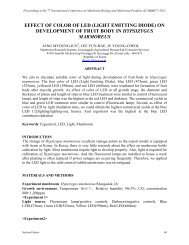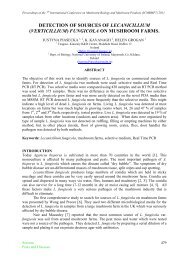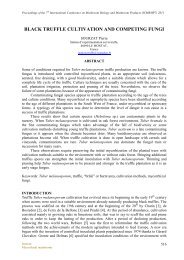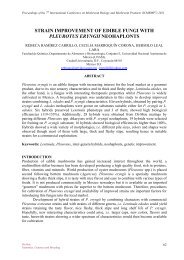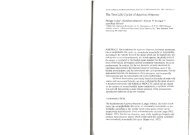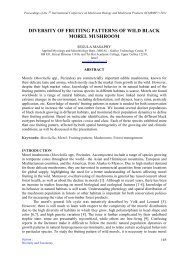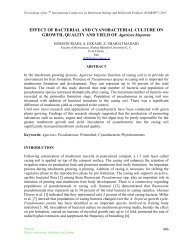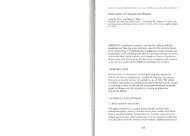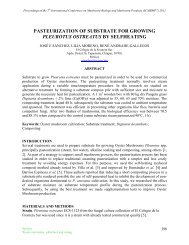Molecular identification of mating type genes in asexual spores of ...
Molecular identification of mating type genes in asexual spores of ...
Molecular identification of mating type genes in asexual spores of ...
Create successful ePaper yourself
Turn your PDF publications into a flip-book with our unique Google optimized e-Paper software.
Proceed<strong>in</strong>gs <strong>of</strong> the 7 th International Conference on Mushroom Biology and Mushroom Products (ICMBMP7) 2011<br />
conta<strong>in</strong><strong>in</strong>g two <strong>type</strong>s <strong>of</strong> <strong>mat<strong>in</strong>g</strong>-<strong>type</strong> <strong>genes</strong>. So these stra<strong>in</strong>s were believed to be heterokaryons<br />
conta<strong>in</strong><strong>in</strong>g two k<strong>in</strong>ds <strong>of</strong> nucleus. The other 138 s<strong>in</strong>gle spore isolate stra<strong>in</strong>s only conta<strong>in</strong>ed one <strong>type</strong><br />
<strong>of</strong> <strong>mat<strong>in</strong>g</strong>-<strong>type</strong> loci, which showed that their hypha cell just conta<strong>in</strong> one k<strong>in</strong>d <strong>of</strong> nucleus and they<br />
were homokaryons.<br />
Table 2: The statistical results <strong>of</strong> the k<strong>in</strong>d <strong>of</strong> <strong>mat<strong>in</strong>g</strong> <strong>type</strong> <strong>genes</strong> <strong>of</strong> <strong>asexual</strong> spore stra<strong>in</strong>s, isolated from<br />
Cordyceps militaris<br />
Types <strong>of</strong> <strong>asexual</strong><br />
spore stra<strong>in</strong>s<br />
K<strong>in</strong>ds <strong>of</strong> <strong>mat<strong>in</strong>g</strong> <strong>type</strong><br />
<strong>genes</strong><br />
stra<strong>in</strong>s derived<br />
from CM-23B<br />
stra<strong>in</strong>s derived<br />
from CM-H07<br />
Parental <strong>type</strong> MAT1-1-1, MAT1-1-2, 35 37<br />
MAT1-2-1<br />
Alpha <strong>type</strong> MAT1-1-1, MAT1-1-2 40 33<br />
HMG <strong>type</strong> MAT1-2-1 25 30<br />
Total 100 100<br />
Figure 1. The germ<strong>in</strong>ation status <strong>of</strong> <strong>asexual</strong> spore (The seventh day)<br />
750bp<br />
500bp<br />
1000bp<br />
750bp<br />
1000bp<br />
750bp<br />
M 1 2 3 4 5 6 7 8 9 10 11 12 13 14 15 16 17 18 19 20 M CK<br />
Figure 2: The partial amplification results <strong>of</strong> <strong>mat<strong>in</strong>g</strong> <strong>type</strong> <strong>genes</strong> fragment <strong>in</strong> s<strong>in</strong>gle-spore isolates (M:<br />
D2000 DNA marker; 1-20: isolates No. 1-20 from CM-23B; CK:CM-23B;A:MAT1-1-1; B:MAT1-1-<br />
2; C:MAT1-2-1)<br />
A<br />
B<br />
C<br />
Section:<br />
Genomics, Genetics and Breed<strong>in</strong>g<br />
55



